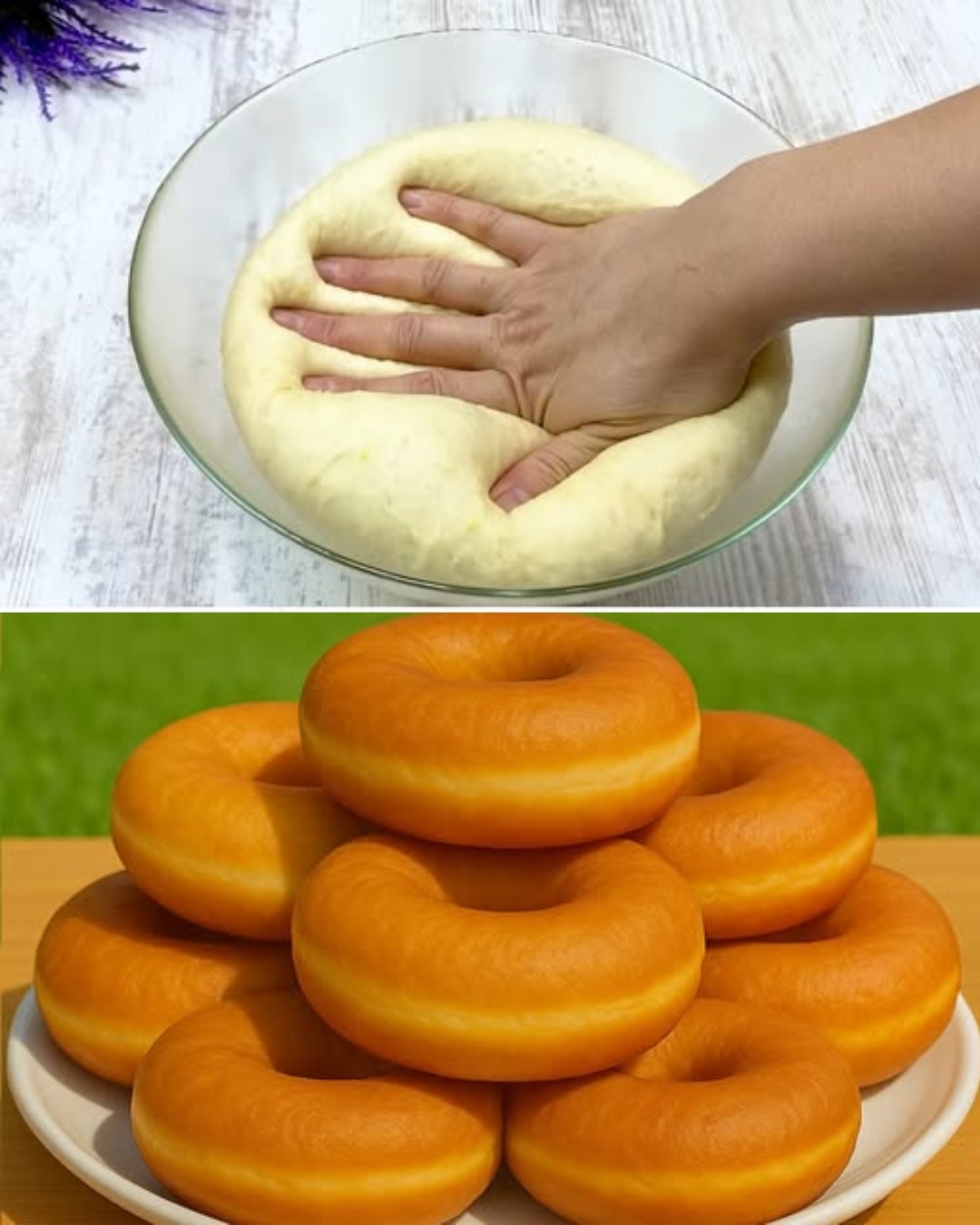There’s nothing quite like biting into a freshly made donut—soft, fluffy, and just the right amount of sweetness. Italian Donuts, known as “Graffe” or “Ciambelle” depending on the region, are a beloved traditional treat that brings warmth and comfort to any kitchen. These homemade donuts boast a light, airy interior and a golden, crisp exterior, often dusted in sugar and sometimes filled or flavored. Whether served at breakfast, during coffee breaks, or as a festive treat, this recipe is a tribute to Italy’s passion for simple yet soul-satisfying pastries. Once you’ve tried these, store-bought donuts will never be the same again.
Cooking Time
Preparation Time: 20 minutes
Resting/Rising Time: 1½ to 2 hours
Cooking Time: 20 minutes
Total Time: 2 hours 10 minutes
Yield: 12–16 donuts
Ingredients
-
All-Purpose Flour: 3½ cups (450 g)
-
Dry Yeast: 2¼ teaspoons (1 packet)
-
Granulated Sugar: ⅓ cup (65 g)
-
Milk (warm): ¾ cup (180 ml)
-
Butter (melted and cooled): 4 tablespoons (60 g)
-
Eggs: 2 large
-
Salt: ½ teaspoon
-
Vanilla Extract: 1 teaspoon
-
Lemon or Orange Zest (optional): 1 tablespoon
-
Neutral Oil (for frying): as needed
-
Extra Sugar: for dusting
Step-by-Step Cooking Directions
-
Activate the Yeast
Warm the milk (not hot—around 100–110°F or 37–43°C), then mix in the sugar and dry yeast. Let it sit for 5–10 minutes until it becomes foamy on top. -
Make the Dough
In a large bowl, combine the flour, salt, eggs, melted butter, vanilla extract, and citrus zest (if using). Pour in the yeast mixture and knead until a smooth dough forms. This may take 8–10 minutes by hand or 5–6 minutes with a dough hook. -
Let the Dough Rise
Cover the bowl with a kitchen towel or plastic wrap. Let the dough rise in a warm place for 1½ hours or until doubled in size. -
Shape the Donuts
Once risen, punch down the dough and roll it out to about ½ inch thick on a floured surface. Use a donut cutter or two round cutters (one larger, one smaller) to cut out donut shapes. Re-roll and repeat with remaining dough. -
Second Rise
Place the donuts on a floured tray, cover them loosely, and let them rise for another 30 minutes until puffed. -
Fry the Donuts
Heat oil in a deep pan to 170–180°C (340–360°F). Fry the donuts in batches for about 2–3 minutes per side until golden brown. Use a slotted spoon to remove and drain on paper towels. -
Coat in Sugar
While still warm, roll the donuts in granulated sugar to coat. -
Serve
Serve immediately, or fill with jam, custard, or chocolate for extra indulgence.
Nutritional Information (Per Donut, approx.)
-
Calories: 210
-
Carbohydrates: 30 g
-
Protein: 4 g
-
Fat: 8 g
-
Sugar: 8 g
-
Fiber: 1 g
The Origins and Popularity of the Recipe
Italian donuts have long been associated with Carnevale—the Italian Mardi Gras celebration. From Naples to Milan, each region boasts its variation of fried dough treats, such as Graffe Napoletane (often made with mashed potatoes) or Ciambelle Fritte. These homemade sweets are now popular year-round thanks to their irresistible flavor and easy preparation. Their rise in popularity is also due to how customizable they are—different fillings, glazes, or even baked versions exist.
Reasons Why You’ll Love This Recipe
-
Soft, fluffy interior with a golden crust
-
Classic flavor with a citrusy twist
-
Perfectly sweet and customizable
-
Ideal for breakfast, dessert, or festive occasions
-
Better than store-bought and made from scratch
Health Benefits
While donuts are traditionally indulgent, making them at home gives you full control over the ingredients. Use:
-
Less sugar or whole wheat flour for added fiber
-
Natural flavorings like citrus zest or vanilla
-
Baking instead of frying for a lighter version
And since they’re homemade, you can avoid preservatives and artificial additives.
Serving Suggestions
-
Serve warm with an espresso or cappuccino
-
Dip in melted chocolate or drizzle with glaze
-
Fill with pastry cream, Nutella, or strawberry jam
-
Dust with cinnamon sugar for a spicy-sweet twist
-
Pair with fresh fruit for a brunch platter
Common Mistakes to Avoid
-
Overheating the milk: can kill the yeast
-
Under-kneading the dough: results in dense donuts
-
Skipping the second rise: leads to flat donuts
-
Frying at the wrong temperature: too hot burns the outside, too cold absorbs too much oil
-
Not draining properly: can make them greasy
Pairing Recommendations
-
Drinks: Italian coffee, hot chocolate, Prosecco for brunch
-
Sauces: Vanilla glaze, lemon drizzle, or raspberry coulis
-
Sides: Fruit salad, whipped cream, or yogurt
Cooking Tips
-
If your kitchen is cold, place the dough in the oven with just the light on (no heat) to rise.
-
Use a kitchen thermometer for the oil to ensure proper frying temperature.
-
Don’t overcrowd the pan; fry in small batches.
-
Make smaller donut holes with leftover dough centers.
-
For a baked version, bake at 180°C (350°F) for 12–15 minutes and brush with butter after baking.
Similar Recipes to Try
-
Baked Ricotta Donuts
-
Filled Bomboloni (Italian cream-filled donuts)
-
Zeppole (mini fried Italian dough balls)
-
Churros with cinnamon sugar
-
Doughnut Muffins with Glaze
Variations to Try
-
Lemon-glazed Donuts: with lemon zest and juice in the glaze
-
Chocolate-dipped Donuts: dipped in melted dark or white chocolate
-
Cinnamon-Sugar Donuts: roll in a mix of sugar and cinnamon
-
Jam-filled Donuts: fill with raspberry or apricot jam
-
Nutella Donuts: pipe Nutella into the center after frying
Ingredient Spotlight
Flour
The base of your donut structure. All-purpose flour gives a good balance of tenderness and strength.
Dry Yeast
Leavens the dough, giving it a light, airy structure. Make sure it’s active and not expired for best results.
Sugar
Adds sweetness and helps yeast fermentation. Also used for rolling and finishing the donuts.
Milk
Warm milk activates the yeast and adds moisture and richness to the dough.
Butter
Provides flavor and tenderness. It’s important to cool melted butter before mixing.
Eggs
Add structure and richness, helping bind the dough.
Vanilla & Citrus Zest
Enhances the aroma and flavor with a fresh, sweet profile typical of Italian desserts.
Conclusion
These Italian Donuts are more than just a sweet treat—they’re a celebration of texture, tradition, and timeless flavor. Light and fluffy with just the right amount of sweetness, this recipe delivers bakery-quality results in the comfort of your own kitchen. Whether you’re new to donut-making or a seasoned baker, this foolproof recipe will quickly become your go-to for special occasions and weekend indulgence alike.
Frequently Asked Questions
1. Can I make the dough ahead of time?
Yes! You can refrigerate the dough overnight after the first rise. Let it come to room temperature before shaping.
2. What oil is best for frying?
Neutral oils like canola, sunflower, or vegetable oil work best due to their high smoke point.
3. Can I bake these instead of frying?
Yes. Bake at 180°C (350°F) for 12–15 minutes. Brush with melted butter and roll in sugar for best results.
4. How do I store leftover donuts?
Keep them in an airtight container at room temperature for up to 2 days. Reheat slightly before serving.
5. Can I freeze the donuts?
Yes, freeze them after frying (before coating with sugar) and reheat in the oven when ready to eat.
6. Why didn’t my donuts puff up?
The yeast may not have activated properly, or the dough didn’t rise long enough. Ensure the yeast is fresh and your kitchen is warm enough for proofing.
Advertisement
7. How do I fill the donuts?
Use a piping bag with a long tip to fill donuts with jam, custard, or chocolate after frying.
8. Can I use instant yeast instead of active dry?
Yes, you can substitute in equal amounts. Just mix it directly with the dry ingredients.
9. What kind of sugar works best for coating?
Fine granulated sugar sticks well to warm donuts. You can also use powdered sugar or cinnamon sugar.
10. Can I make mini donuts with this recipe?
Absolutely! Just reduce the frying time slightly, as smaller donuts will cook faster

